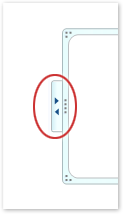Note: This article has done its job, and will be retiring soon. To prevent "Page not found" woes, we're removing links we know about. If you've created links to this page, please remove them, and together we'll keep the web connected.
A radial list graphically shows parts coming together to form one main or central idea. For example, you could use a radial list to show groups that make up a whole, such as the different groups of people necessary to create a successful theater production: cast, crew, and audience. When you use a radial list, you can display a picture in the main circle of the graphic. By using a SmartArt graphic, you can create a radial list and include it in your worksheet, e-mail message, presentation, or document.

-
Click the Insert tab, and then click SmartArt.

-
In the Choose a SmartArt Graphic gallery, click Relationship, and then double-click Radial List.
-
To add a picture to the central circle, click the picture icon

-
To enter text, do one of the following:
-
Click [Text] in the Text pane, and then type your text.
-
Copy text from another location or program, click [Text] in the Text pane, and then paste your text.
Note: If the Text pane is not visible, click the control.

-
Click in a circle in the SmartArt graphic, and then type your text.
Note: For best results, use this option after you add all of the circles that you want.
-
Add a circle
-
Click the SmartArt graphic you want to add a circle to.
-
Click the existing circle located closest to where you want to add the new circle.
-
Click the Design tab under SmartArt Tools, and then click the arrow under Add Shape.

If you don't see the SmartArt Tools or Design tabs, make sure you've selected the SmartArt graphic.
-
Do one of the following:
-
To insert a circle after the selected circle, click Add Shape After.
-
To insert a circle before the selected circle, click Add Shape Before.
-
Delete a circle
To delete a circle, click the border of the circle you want to delete, and then press DELETE.
Notes:
-
When you need to add a circle to your radial list, experiment with adding the circle before or after the selected circle to get the placement you want for the new circle.
-
To add a circle from the Text pane:
-
At the circle level, place your cursor at the end of the text where you want to add a new circle.
-
Press ENTER, and then type the text that you want in your new circle.
-
To move a circle, click the circle and then drag it to its new location.
-
To move a circle in very small increments, hold down CTRL while you press the arrow keys on your keyboard.
To quickly add a designer-quality look and polish to your SmartArt graphic, you can change the colors or apply a SmartArt style to your radial list. You can also add effects, such as glows, soft edges, or 3-D effects. In PowerPoint presentations, you can animate your radial list.
You can apply color combinations that are derived from the theme colors to the circles in your SmartArt graphic.
-
Click the SmartArt graphic whose color you want to change.
-
Click the Design tab under SmartArt Tools, and then click Change Colors.

If you don't see the SmartArt Tools or Design tabs, make sure that you've selected a SmartArt graphic.
-
Click the color combination you want.
Tip: When you place your pointer over a thumbnail, you can see how the colors affect your SmartArt graphic.
Change the line color or style of a circle's border
-
In the SmartArt graphic, right-click the border of the circle you want to change, and then click Format Shape.
-
To change the color, weight, and appearance of the circle's border, click Outline, and then click the options you want.
-
To change the style of the circle's border, click Style, and then choose the line style you want.
Change the background color of a circle in your radial list
-
Right-click the border of a circle, click Format Shape, and then click Fill.
-
Click the color you want.
-
Choose Gradient to specify how much you can see through the background color. You can also vary the percentage of transparency from 0% (fully opaque, the default setting) to 100% (fully transparent) from the Fill pane.
A SmartArt Style is a combination of various effects, such as line style, bevel, or 3-D, that you can apply to the circles in your SmartArt graphic to create a unique and professionally designed look.
-
Click the SmartArt graphic whose SmartArt Style you want to change.
-
Click the Design tab under SmartArt Tools, and then click the SmartArt Style you want.

Click the arrow next to the SmartArt Styles group for styles that best match the document and other style options.
If you don't see the SmartArt Tools or Design tabs, make sure you've selected a SmartArt graphic.
Notes:
-
When you place your pointer over a thumbnail, you can see how the SmartArt Style affects your SmartArt graphic.
-
You can also customize your SmartArt graphic by moving circles, resizing circles, adding a fill or effect, and adding a picture.
-
If you're using PowerPoint, you can animate your radial list to emphasize each circle.
-
Click the SmartArt graphic radial list that you want to animate.
-
On the Animations tab, click Animate, and then click One by one.
Note: If you copy a radial list that has an animation applied to it to another slide, the animation is also copied.










